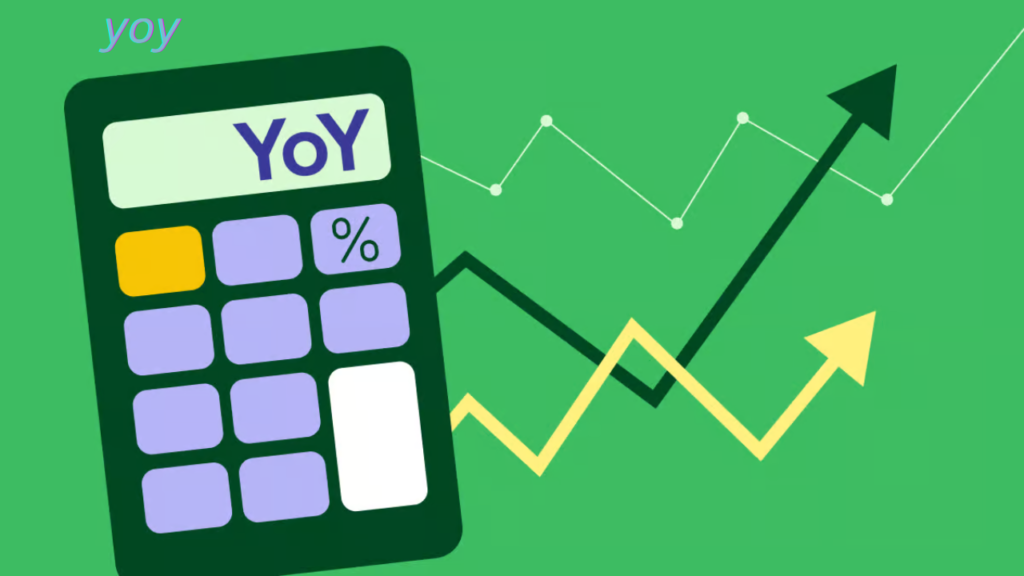YOY A Comprehensive Guide to Understanding Year-over-Year Metrics and Their Impact
Year-over-Year (YOY) is one of the most widely used metrics in business and financial analysis. It provides valuable insights into performance trends, allowing companies, investors, and analysts to make informed decisions. YOY compares a specific metric (such as revenue, profit, or customer growth) from one year to the same metric from the previous year. This allows businesses to assess their growth, track progress, and spot any patterns or anomalies. In this article, we will explore the concept of YOY, how it’s calculated, its role in business and financial analysis, and its real-world applications across different industries. By the end, you’ll have a solid understanding of how to interpret YOY data and use it effectively in your analysis.
What is Year-over-Year (YOY)?
Year-over-Year (YOY) is a financial metric that compares data from one period to the same period in the previous year. It is commonly used to measure the growth or decline in various key metrics, such as revenue, profits, market share, or customer numbers. This time-based comparison helps to eliminate seasonal fluctuations that may skew short-term data, providing a clearer picture of long-term performance trends.
The primary advantage of YOY is that it gives context to data. For example, a company might experience an increase in revenue, but without comparing it to the same period in the prior year, it’s difficult to gauge whether this increase is part of a larger growth trend or merely a temporary spike. By using YOY, businesses can more accurately assess their growth trajectory and identify any significant changes in their operations or the broader market environment.
YOY is also highly valuable because it normalizes data by removing seasonal effects. For instance, many retail businesses see significant sales spikes during the holiday season. A month-over-month comparison could be misleading during this period, but a YOY comparison would consider this seasonal impact, allowing for a more accurate understanding of the company’s performance.
How is YOY Calculated?
The formula for calculating YOY growth is simple yet powerful. It is calculated by taking the current period’s value, subtracting the previous year’s value, and then dividing that number by the previous year’s value. The result is multiplied by 100 to get the percentage change. Here’s the formula:
YOY Growth = ((Current Value – Previous Year Value) / Previous Year Value) * 100
For example, if a company’s revenue this year is $5 million and its revenue from the same period last year was $4.5 million, the YOY growth would be:
YOY Growth = (($5,000,000 – $4,500,000) / $4,500,000) * 100 = 11.11%
This means that the company experienced an 11.11% growth in revenue compared to the same period last year.
When calculating YOY, it’s essential to account for various factors that could influence the data. For instance, businesses may need to adjust for significant changes in their operations or industry-wide conditions that could distort the comparison. Additionally, YOY data can be influenced by external variables like inflation, currency fluctuations, or changes in government policy, so context is crucial when interpreting the results.
The Role of YOY in Business and Financial Analysis
YOY is a critical tool for business owners, financial analysts, and investors. It helps in evaluating how well a company is performing over time, allowing stakeholders to identify growth trends or signs of stagnation. For example, a company that shows consistent YOY revenue growth can be seen as successful in expanding its customer base or improving operational efficiency. On the other hand, a company experiencing negative YOY growth may face challenges, signaling potential issues that need addressing.
In financial analysis, YOY is used extensively in quarterly or annual reports to showcase key financial metrics such as revenue, profits, and earnings per share (EPS). By comparing these figures to the same period in the previous year, investors gain insight into a company’s financial health and its ability to generate consistent profits. YOY growth is often seen as a sign of strong business fundamentals and long-term viability.
For investors, YOY growth can also help in making investment decisions. When analyzing stocks, many investors look at YOY growth in revenue and earnings to assess whether a company is growing at a healthy rate. Companies with consistent positive YOY growth are generally more attractive to investors because they signal long-term stability and profitability.
Moreover, YOY is essential in macroeconomic analysis. Economists use YOY data to track key economic indicators like GDP, inflation, and unemployment rates. This broader analysis helps policymakers and businesses make informed decisions about the economy and future investment strategies.
Real-World Applications of YOY in Various Industries

YOY metrics are used across numerous industries to track performance, identify trends, and evaluate growth potential. Here’s how YOY is applied in several key sectors:
- Retail and E-commerce: YOY is particularly useful in retail and e-commerce, where businesses often experience seasonal fluctuations. By comparing the same period year-over-year, companies can understand how sales growth is progressing and if their strategies, such as promotions or new product launches, are effective. For example, if a retail business sees a 20% YOY increase in sales during a specific quarter, it indicates that the business is expanding its market presence and attracting more customers.
- Technology: In the tech industry, YOY is commonly used to measure market share growth and the performance of new products. For instance, a tech company might compare the sales of its latest smartphone model to the previous year’s model to assess its market reception. This helps companies understand if they are innovating successfully and maintaining customer interest over time.
- Healthcare: Healthcare organizations rely on YOY comparisons to track patient volumes, revenue growth, and service utilization. Hospitals may use YOY metrics to analyze the number of patients treated, the revenue generated, or the adoption of new medical technologies. These insights help healthcare providers optimize operations and predict future trends.
- Real Estate: YOY analysis in real estate helps track property sales, market prices, and demand trends. Real estate agents and investors use YOY comparisons to determine whether the housing market is appreciating or depreciating. For example, a YOY increase in housing prices might indicate a growing demand for properties in a particular area, signaling a good investment opportunity.
- Economics: Economists frequently use YOY data to analyze broader economic trends, such as inflation, GDP growth, and employment rates. This helps governments and businesses understand the direction of the economy, anticipate potential downturns, or spot growth opportunities.
Common Pitfalls and Challenges in YOY Analysis
While YOY is an excellent tool for understanding performance trends, there are several challenges that analysts and businesses must be aware of. One of the most significant pitfalls is the impact of seasonal fluctuations. For instance, companies in the retail sector often experience substantial sales spikes during the holiday season. Comparing holiday sales from one year to another may not provide an accurate representation of overall performance because these periods are inherently different from non-holiday months.
Changes in market conditions can also affect YOY comparisons. Economic events, like recessions or global disruptions, can create temporary distortions in data. For example, the COVID-19 pandemic had a profound impact on many industries, and comparing 2020 performance to previous years could be misleading without considering the pandemic’s effects.
Another challenge is the potential for over-reliance on YOY metrics. While YOY provides valuable insights, it should not be the only metric used in analysis. A comprehensive view of a company’s performance should also include other metrics such as month-over-month (MoM) data, quarterly comparisons, and forward-looking projections. Relying solely on YOY data can overlook short-term trends or significant shifts in the market.
Conclusion
Year-over-Year (YOY) metrics are essential for assessing the performance of businesses and industries, providing valuable insights into growth, profitability, and trends. Whether you’re a business owner, financial analyst, or investor, understanding how to calculate and interpret YOY data can help make informed decisions and predict future performance. However, it’s essential to consider external factors such as https://www.investopedia.com/terms/y/year-over-year.aspseasonality and market conditions, as these can influence YOY comparisons. By using YOY alongside other relevant metrics, you can gain a clearer picture of a company’s performance and make better-informed decisions for long-term success.
FAQs
What does YOY stand for, and why is it important?
YOY stands for Year-over-Year, and it’s used to compare key metrics like revenue or profit between the same periods in two consecutive years, helping businesses gauge long-term performance.
How do you calculate YOY growth?
YOY growth is calculated by subtracting last year’s value from this year’s value, dividing by last year’s value, and then multiplying by 100 to get the percentage change.
What are the main benefits of using YOY metrics?
YOY helps eliminate seasonal fluctuations and gives a clearer picture of long-term trends, aiding businesses and investors in decision-making.
Can YOY be used for non-financial data analysis?
Yes, YOY can be used to compare various non-financial data such as customer numbers, website traffic, or production volumes.
How does YOY differ from other time-based comparisons like MoM (Month-over-Month)?
YOY compares the same period in consecutive years, while MoM compares data from one month to the next, making YOY better for identifying long-term trends and growth patterns.
You May Also Read: https://networkinfonews.com/dow-today/














Post Comment